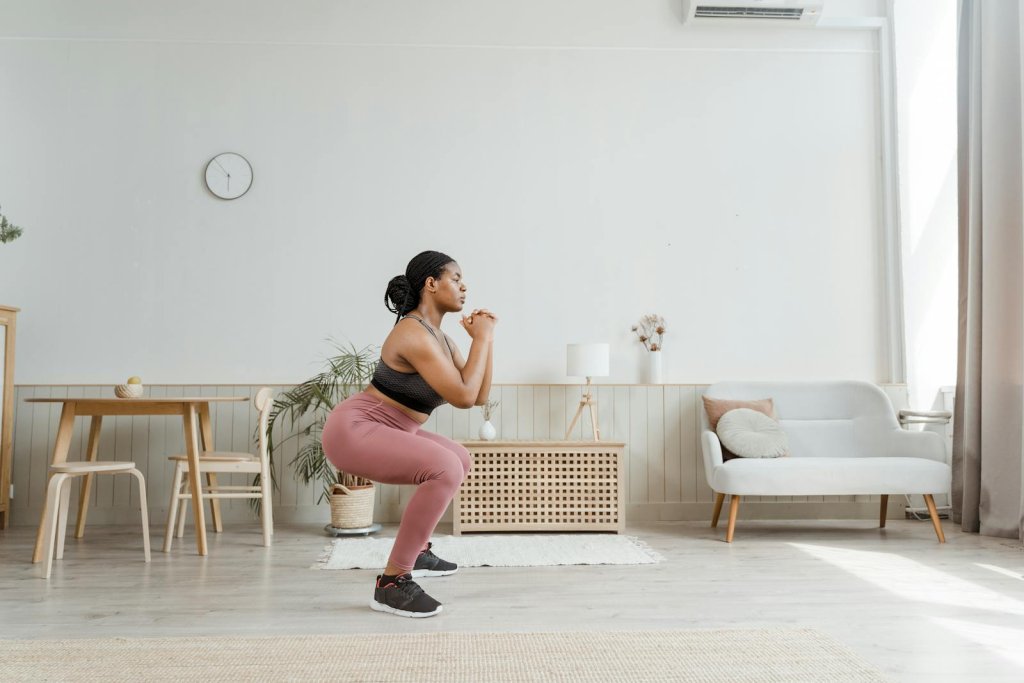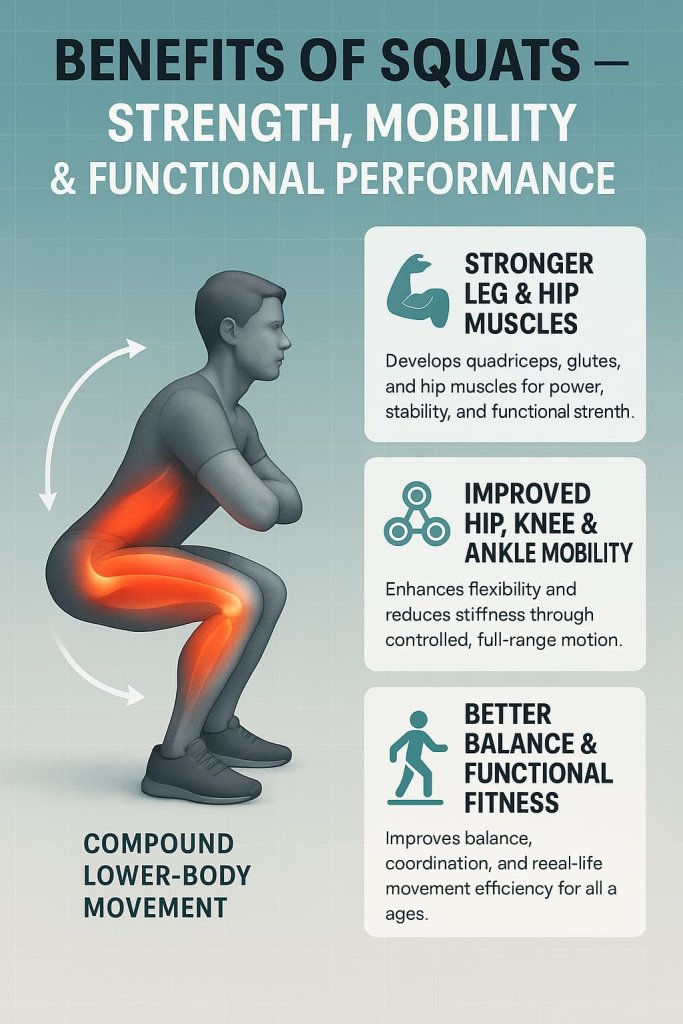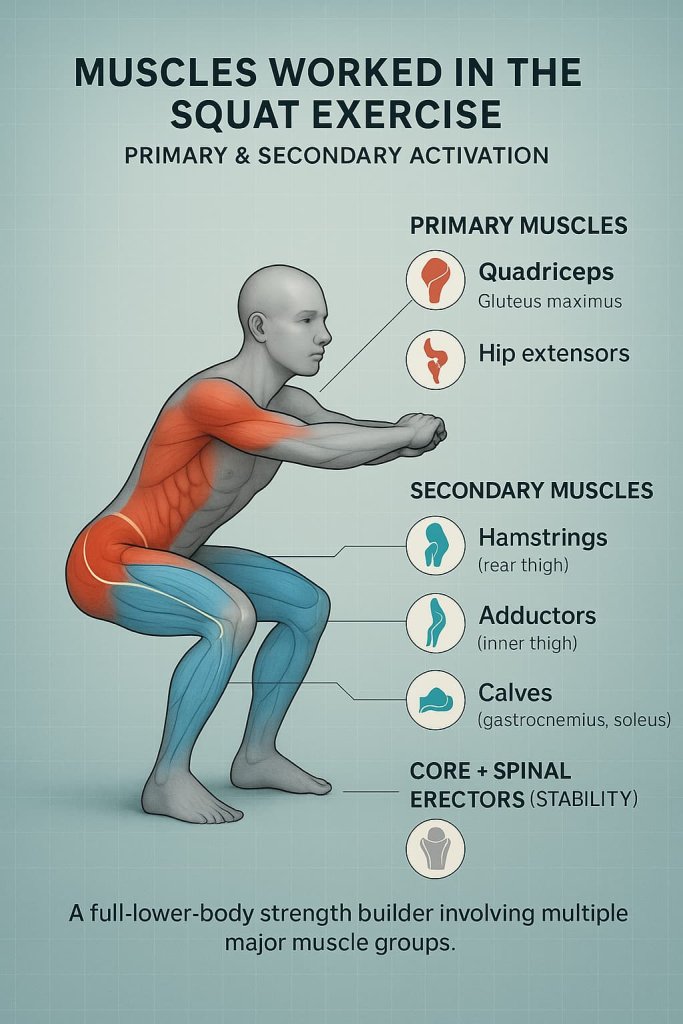Yes—squats are one of the most effective exercises for building stronger legs and improving overall mobility.
The squat is a foundational movement used in everyday life, which makes mastering it essential for strength, joint health, balance, and long-term functional fitness.

This guide explains how squats work, which muscles they target, how to perform them correctly, common mistakes to avoid, beginner-to-advanced variations, and evidence-based programming to fit your goals.
What Is the Squat Exercise?
The squat is a compound lower-body movement that involves bending at the hips, knees, and ankles to lower the body and then return to standing. Because it uses multiple joints and major muscle groups, it is frequently included in strength training, rehabilitation, mobility drills, sports performance programs, and general fitness plans.

Benefits of Squats for Strength & Mobility
Squats deliver a wide range of benefits supported by current strength-training and mobility research.
Stronger Leg & Hip Muscles
Squats emphasize the quadriceps, gluteus maximus, and surrounding hip muscles responsible for powerful lower-body movement. Regular practice helps increase strength, muscle size, and functional control.
Improved Hip, Knee & Ankle Mobility
Squatting through a controlled, comfortable range of motion improves joint flexibility, reduces stiffness from sitting, and promotes better movement mechanics.

Better Balance & Functional Fitness
Since squats train your ability to sit, stand, lift, and stabilize, they improve balance and everyday function—important for all ages, especially beginners and older adults.
Supports Metabolic & Bone Health
Lower-body strength training supports healthy metabolism, increases energy expenditure, and contributes to bone density through weight-bearing loading.
How to Do the Squat Exercise (Step-by-Step)
How to Do It
- Stand with feet shoulder-width apart or slightly wider.
- Point toes slightly outward based on your natural hip structure.
- Brace your core and keep your chest lifted.
- Sit your hips back while bending your knees.
- Lower until thighs are parallel to the floor or your comfortable depth.
- Keep knees tracking over your toes—avoid collapsing inward.
- Press through your heels/mid-foot and stand back up.
- Maintain a neutral spine throughout the movement.
- Breathe in as you lower, breathe out as you rise.
Trainer Tip
Film yourself once per week. Aim for knee alignment, flat feet, neutral spine, and smooth tempo. Quality always matters more than depth.
Muscles Worked in the Squat Exercise
The squat engages multiple major muscle groups:

Primary Muscles
- Quadriceps
- Gluteus maximus
- Hip extensors
Secondary Muscles
- Hamstrings
- Adductors
- Calves (gastrocnemius, soleus)
- Core & spinal erectors (for trunk stabilization)
This combination makes the squat one of the best full-lower-body strength builders.
Programming Guidelines for Strength & Mobility
Use evidence-based resistance-training recommendations to structure your squat training.
How Often to Squat
- 2–3 training sessions per week is effective for most people
- Beginners can start with 1–2 sessions per week
- Advanced lifters may squat several times weekly with variation in load and intensity
Sets, Reps & Load
| Goal | Reps | Sets | Load | Rest |
|---|---|---|---|---|
| Strength | 1–6 | 3–5 | Heavy | 2–4 min |
| Hypertrophy | 6–12 | 2–4 | Moderate | 1–2 min |
| Endurance / Mobility | 12–20+ | 1–3 | Light / Bodyweight | 30–60 sec |
Progression
Increase one variable at a time:
- Add weight
- Add reps
- Add sets
- Increase depth (only if pain-free)
- Slow down tempo (e.g., 3-second descent)
Best Squat Variations for All Levels
Beginner Variations
Bodyweight Squat
Why it works:
This foundational squat variation teaches balance, alignment, and proper lower-body mechanics without external load. It helps you master hip hinging, knee tracking, and depth control—essential before progressing to weighted squats.
Muscles worked:
Quadriceps, gluteus maximus, hamstrings, calves, core stabilizers.
How to do it:
- Stand tall with feet shoulder-width apart.
- Brace your core and keep your chest up.
- Push your hips back and bend your knees.
- Lower into a comfortable depth with heels flat.
- Press through your mid-foot/heels to rise back up.
Trainer Tip:
Pause briefly at the bottom to check knee tracking and posture. Perfect form here makes every other squat variation easier.
Chair/Box Squat
Why it works:
This variation builds confidence and keeps depth consistent. It reinforces safe hip mechanics and reduces stress on the lower back by giving beginners a clear target to sit toward.
Muscles worked:
Quadriceps, glutes, hamstrings, core.
How to do it:
- Stand in front of a chair or box with feet shoulder-width apart.
- Reach hips back and lower until you lightly touch the chair.
- Keep knees aligned with toes throughout.
- Stand up by pushing through heels and squeezing glutes.
Trainer Tip:
Avoid fully sitting down—tap the chair lightly and stand up immediately to maintain tension and form.
Wall Squat
Why it works:
Wall squats encourage upright posture and thigh engagement without excessive knee stress. They build endurance in the quads and improve body awareness.
Muscles worked:
Quadriceps, glutes, hamstrings, core.
How to do it:
- Stand with your back against a wall, feet forward about 12–18 inches.
- Slide down until thighs are parallel or comfortable.
- Hold the position while keeping knees in line with toes.
- Press evenly through your feet.
Trainer Tip:
Start with short holds (10–20 seconds) and gradually increase time as your endurance improves.
Supported TRX Squat
Why it works:
Assisted squatting reduces load on the knees and back while letting beginners practice deeper ranges safely. The handles help improve balance and confidence.
Muscles worked:
Quadriceps, glutes, hamstrings, calves, core.
How to do it:
- Hold the TRX handles with arms extended.
- Lean back slightly for support.
- Lower into a squat while keeping chest lifted.
- Drive through heels to stand up.
Trainer Tip:
Use minimal TRX assistance—let your legs do most of the work to build strength.
Intermediate Variations
Goblet Squat
Why it works:
Holding a dumbbell or kettlebell in front shifts your center of gravity forward, encouraging an upright torso and helping you achieve deeper, clean squats. Ideal for strength and mobility.
Muscles worked:
Quadriceps, glutes, adductors, hamstrings, core, upper back stabilizers.
How to do it:
- Hold a dumbbell/kettlebell at chest level.
- Stand with feet shoulder-width apart.
- Drop into a squat while keeping elbows inside your knees.
- Press through heels to return to standing.
Trainer Tip:
Actively “pull” yourself into the bottom of the squat—this boosts control and mobility.
Split Squat
Why it works:
A unilateral (single-leg) movement that builds balanced strength, improves hip stability, and exposes left-right weaknesses. Excellent for mobility and functional control.
Muscles worked:
Quads, glutes, hamstrings, adductors, calf stabilizers.
How to do it:
- Step one foot forward and one back.
- Keep torso tall and core braced.
- Lower into a lunge with both knees bending.
- Push through the front heel to rise.
Trainer Tip:
If your balance wobbles, narrow your stance slightly instead of widening it.
Bulgarian Split Squat
Why it works:
This variation significantly increases glute and quad activation while improving balance, stability, and mobility. It is one of the highest-return unilateral strength exercises.
Muscles worked:
Glutes, quadriceps, hamstrings, core, hip stabilizers.
How to do it:
- Place your back foot on a bench behind you.
- Step your front foot far enough forward for knee tracking.
- Lower hips straight down until your front thigh is parallel.
- Push through the front heel to rise.
Trainer Tip:
Keep 80–90% of your weight on the front leg. The rear leg is for balance only.
Front Squat (Light–Moderate Load)
Why it works:
Front-loaded positioning challenges the quads more, improves posture, and reduces spinal stress. It’s excellent for learning upright squat mechanics.
Muscles worked:
Quadriceps, glutes, adductors, upper back, core.
How to do it:
- Hold a barbell/dumbbells in front-rack position.
- Keep elbows high to maintain bar alignment.
- Squat down with a tall torso.
- Drive upward while keeping elbows lifted.
Trainer Tip:
If wrist mobility limits you, use a cross-arm grip or straps to support the bar.
Advanced Variations
Barbell Back Squat (High-Bar or Low-Bar)
Why it works:
The back squat allows heavy loading, making it one of the best exercises for full lower-body strength, muscle gain, and power. High-bar is more upright; low-bar increases hip drive.
Muscles worked:
Quadriceps, glutes, hamstrings, adductors, spinal erectors, core.
How to do it:
- Position bar across upper back (high-bar) or slightly lower on rear delts (low-bar).
- Brace your core and step back with feet set.
- Sit hips back and descend under control.
- Drive upward through mid-foot/heels.
Trainer Tip:
Use a stance that feels natural—not forced. Different hip anatomies require different squat widths.
Tempo Squat
Why it works:
Slowing the descent increases time under tension, improves control, and enhances mobility. Ideal for lifters seeking better technique and deeper, cleaner squats.
Muscles worked:
Quads, glutes, hamstrings, core, spinal stabilizers.
How to do it:
- Use a 3–5 second descent.
- Pause briefly at the bottom.
- Rise with normal or slow speed.
- Maintain even weight distribution throughout.
Trainer Tip:
Start with light loads until you master the tempo—your muscles will work harder than expected.
Pause Squat
Why it works:
Pausing at the bottom eliminates momentum and builds strength, stability, and confidence in the deepest range of motion. Great for improving sticking points.
Muscles worked:
Quads, glutes, adductors, hamstrings, core.
How to do it:
- Lower into a squat and stop for 1–3 seconds at the bottom.
- Keep tension—don’t relax or collapse.
- Drive up explosively while maintaining alignment.
Trainer Tip:
Focus on breathing—hold your brace during the pause to protect your spine and maximize power.
Pistol Squat Progressions
Why it works:
Single-leg squatting dramatically improves balance, coordination, mobility, and strength. Progressions help train control without needing weights.
Muscles worked:
Quads, glutes, hamstrings, hip stabilizers, core.
How to do it:
- Start with supported pistol squats or box pistols.
- Extend one leg forward while lowering on the other.
- Keep chest lifted and hips squared.
- Control the descent and rise smoothly.
Trainer Tip:
Strengthen ankles and hips separately—these joints heavily influence pistol squat stability.
Mobility Tips for Better Squat Technique
Improve Ankle Mobility
- Deep calf stretch
- Ankle dorsiflexion rocks
- Squat with heels elevated (temporary modification)
Improve Hip Mobility
- 90/90 hip rotations
- Hip flexor stretch
- Glute activation drills (e.g., glute bridges, clamshells)
Improve Thoracic Mobility
- Wall slides
- Cat-cow
- Thoracic rotations
Common Squat Mistakes & Fixes
- Knees caving in
- Fix: strengthen glutes, use mini-band around knees
- Heels lifting off the floor
- Fix: improve ankle mobility or use heel elevation
- Rounded lower back
- Fix: reduce depth; strengthen core; improve hip mobility
- Excessive forward lean
- Fix: adjust stance; strengthen upper back; check ankle mobility
- Descending too quickly
- Fix: slow down and control every part of the movement
Safety Tips for Squat Training
- Warm up for 3–5 minutes before squatting
- Start with bodyweight until form is consistent
- Increase load gradually
- Stop if you experience sharp knee, hip, or back pain
- Use stable footwear with a firm sole
- Keep your core engaged and avoid twisting or leaning sideways
Frequently Asked Questions (FAQ)
1. How deep should I squat?
Squat only as deep as you can while keeping a neutral spine and knees tracking properly. Your depth should be pain-free.
2. Are squats bad for my knees?
No—when performed with proper technique, squats can strengthen the muscles around the knees and improve joint stability.
3. Can beginners do squats?
Absolutely. Start with bodyweight or chair squats and progress gradually.
4. How long does it take to see results?
Most people notice strength and mobility improvements within 4–8 weeks of consistent training.
5. Should I squat every day?
Light mobility squats can be done daily, but strength-focused squat sessions should be spaced out to allow recovery.
6. Do squats help build glutes?
Yes. Squats strongly engage the gluteus maximus—deeper squats tend to activate glutes more.
7. What’s the best squat variation for mobility?
Goblet squats and tempo squats help improve depth, control, and hip/ankle mobility.
Conclusion
Squats are a powerhouse exercise for building stronger legs, improving mobility, and enhancing daily functional movement. Mastering technique, choosing the right variation, and progressing safely ensures long-term benefits without unnecessary strain. Whether you’re a beginner or experienced lifter, incorporating squats consistently will help you move better and feel stronger.
References
- Straub RK, Powers CM. “A Biomechanical Review of the Squat Exercise: Implications for Clinical Practice.” International Journal of Sports Physical Therapy. 2024. https://ijspt.scholasticahq.com/article/94600-a-biomechanical-review-of-the-squat-exercise-implications-for-clinical-practice
- Ribeiro AS et al. “A Brief Review on the Effects of the Squat Exercise on Lower-Limb Muscle Hypertrophy.” Sports Health. 2023. https://www.ingentaconnect.com/content/wk/ssc/2023/00000045/00000001/art00006
- Kubo K et al. “Effects of Squat Training with Different Depths on Lower Limb Muscle Volumes.” European Journal of Applied Physiology. 2019. https://pubmed.ncbi.nlm.nih.gov/31230110/
- Yoshiko A et al. “Impact of Home-Based Squat Training with Two Depths on Lower Limb Muscle Function in Older Adults.” Scientific Reports. 2021. https://www.nature.com/articles/s41598-021-86030-7
- Mohammadi Z et al. “Comparison of the Effect of Otago and Chair Squat Exercises on Fear of Falling and Quality of Life in Older Adults.” Aging Clinical and Experimental Research. 2025. https://link.springer.com/article/10.1007/s40520-025-02951-7
- Aguilera-Castells J et al. “Muscle Activity of Bulgarian Squat: Effects of Additional Vibration and Unstable Surfaces.” Journal of Sports Medicine and Physical Fitness. 2019. https://pmc.ncbi.nlm.nih.gov/articles/PMC6709890/
- Aygun-Polat E et al. “Targeted Muscle Activation in Bulgarian Split Squat Variations: Effects of Trunk Position and Suspension-Based Execution.” BMC Sports Science, Medicine and Rehabilitation. 2025. https://bmcsportsscimedrehabil.biomedcentral.com/articles/10.1186/s13102-025-01306-z
- Stone MH et al. “The Use of Free Weight Squats in Sports: A Narrative Review.” Applied Sciences. 2024. https://www.mdpi.com/2076-3417/14/5/1977
